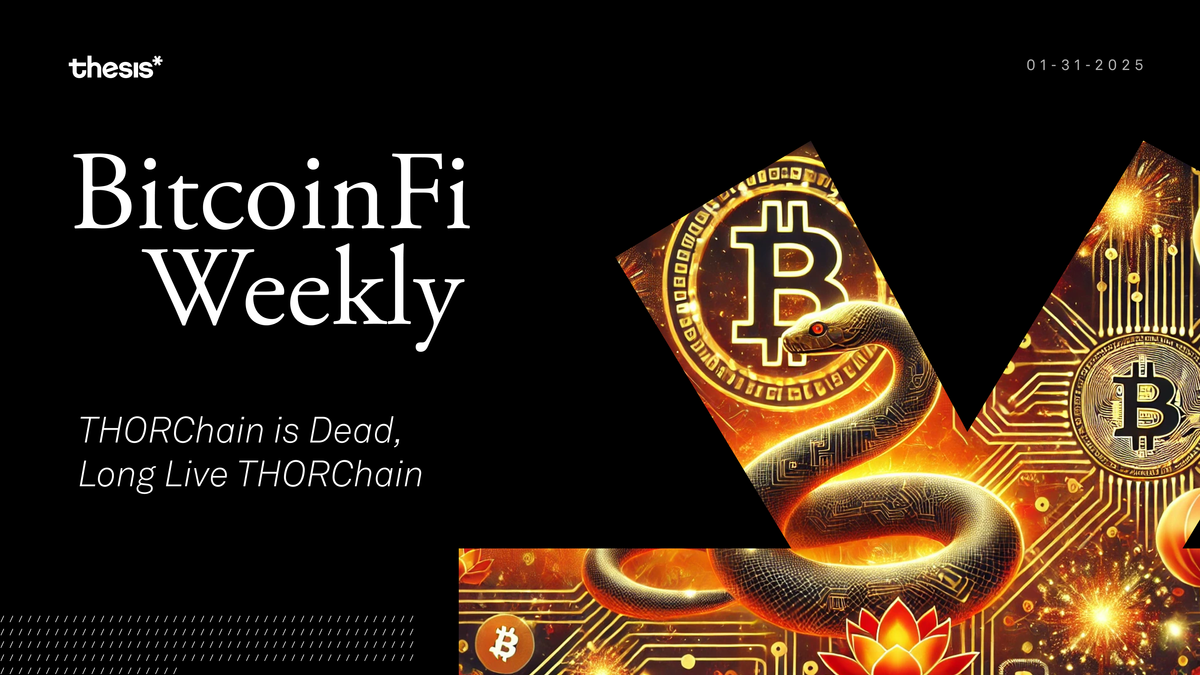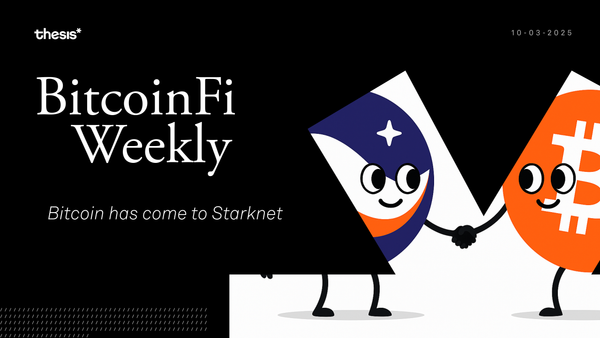THORChain is Dead, Long Live THORChain
Be like the tortoise, measured and deliberate. Align with Bitcoin, step by careful step.

Welcome to BitcoinFi Weekly. We cover where people use their BTC and what is changing in the Bitcoin world.
The thing about success is that it makes people do stupid things. Not regular stupid—like buying a Lamborghini with your first million—but the special kind of stupid that comes from believing you've outsmarted the entire financial system. THORChain had done the impossible: built something that actually worked, made real money, and hadn't blown up yet. Then, they got creative, tied their loans to their token price, and managed to speedrun the Great Depression in less than 72 hours. Meanwhile, the Fed stayed quiet, Michael Saylor became financial Dr. Frankenstein, and someone figured out how to emulate randomness on Bitcoin without breaking the thing. But wait, there’s more! Odin.fun introduces a speedy fix for Runes trading. Let’s see how everyone’s luck holds up this week.
Here’s this week’s rundown:
🔥 Feature Piece: THORChain’s Not so Great, Very Bad Day from Hell
🏦 Fed Holds Steady While Tech Takes a Historic Hit
🎲 Trustless Randomness on Bitcoin
🚀 $MSTR Unveils $STRK
⚡ Odin.fun Bring Speed to Runes
Feature Piece: THORChain’s Not so Great, Very Bad Day from Hell
They say history doesn’t repeat, but it often rhymes. And strangely enough, for one day, THORchain rhymed with Luna. But I am getting ahead of myself. Let’s back it up.
There’s a thing that happens a lot in traditional finance: A bank makes too many loans. The loans go bad. The bank freezes withdrawals. Then there's a restructuring, where everyone pretends the word "restructuring" makes it better.
Here's a thing that happens a lot in crypto: Someone builds a successful thing. Then they get bored and add "innovations." The innovations explode. Everyone loses money.
THORchain did both things! At the same time!
First, some background. THORchain built a pretty good business. They run a decentralized exchange that lets you swap native Bitcoin for other tokens. This is actually hard to do. Bitcoin doesn't have smart contracts (at least back then). THORchain solved this through something called "continuous liquidity pools," where every asset pairs with their RUNE token, and validators who have to lock up twice as much RUNE as collateral to secure the network. It's far less exciting than a bridge, but it turns out boring is good when you're moving millions in crypto. Their exchange processes hundreds of millions in daily volume and generates real revenue. Good for them.
But then. Oh, but then...
See, in crypto, having a working product that makes money is somehow never enough. You always need to add more features. More complexity. More ways to generate yield through increasingly baroque financial engineering.
Imagine if Bank of America looked at its lending business and said, "you know what would make this better? If we tied all our loans to the price of Bank of America stock in a way that could trigger an unstoppable death spiral." That's basically what THORchain did. They added a lending product called THORFi.THORFi offered a simple pitch: You deposit Bitcoin, borrow against it at 0% interest with no liquidation risk, and the protocol creates new RUNE tokens to back your loan. THORFi was designed to work perfectly as long as RUNE's price outperformed Bitcoin. When RUNE went up 10x between September 2023 and March 2024, everyone looked like a genius. More people borrowed, which meant burning more RUNE, which pushed the price up more, which attracted more borrowers... you get the idea.
But here's the thing about financial perpetual motion machines: They only work until they don't.
If RUNE falls 50% against Bitcoin, the protocol suddenly needs to conjure more RUNE to buy back each unit of BTC. That’s inflation, and it cascades. The more tokens minted, the greater the selling pressure, and the more RUNE’s price can drop.
But wait, there’s more! THORFi featured synthetic assets that are minted from half BTC and half RUNE. THORFi promised you no impermanent loss if you held synthetic BTC, which sounded good. But the risk had to go somewhere. In this design, it landed squarely on the liquidity providers, who found themselves even more leveraged to RUNE’s performance. If RUNE cratered, those synth redemptions forced the protocol to dip into the liquidity pools for BTC, which meant more RUNE selling, which meant an even lower token price.
The result is $200 million in user funds now frozen. The protocol is busy minting new RUNE tokens to cover its obligations, which is pushing RUNE's price down further, which means it needs to mint more RUNE, which pushes the price down further, which... you get the idea. It's like trying to put out a fire by throwing smaller fires at it.
The technical term for this is "death spiral." The crypto term is "number go down." The Vaish Puri term is “ya hate to see.”
THORchain is now undergoing “restructuring”, as they put it. A proposal is up for debate and here is the TLDR:
- Immediately pay back 80% of the smallest creditors using $10 million from the treasury.
- Create a new token called $TCBOND that represents the remaining debt.
- Use 20% of protocol revenue in the first year (then 10% afterward) to buy back these tokens at up to 2x their face value. This is actually clever - it gives creditors who want out now a way to sell, while giving patient creditors a potential upside.
- Kill the lending product entirely.
- Stop paying rewards for providing liquidity to the protocol.
The most remarkable thing about this plan is that it's... actually pretty sensible? It treats the debt like debt (novel concept in crypto, I know), creates a market-based mechanism for price discovery, and doesn't rely on magical thinking about token prices only going up.
Of course, not everyone's happy. Some large creditors are furious about the small-creditor payoff, calling it everything from communism to "banker fuckery." Nothing says we believe in free markets quite like demanding equal treatment in a bankruptcy.
Meanwhile, their actual exchange business keeps processing hundreds of millions in volume.
BitcoinFi Updates
Fed Holds Steady While Tech Takes a Historic Hit
The Federal Reserve maintained its steady course this week, keeping rates between 4.25% and 4.5% while emphasizing its commitment to the 2% inflation target amid strong employment numbers. The market response was measured, with the S&P climbing 0.53%. Bitcoin showed resilience, trading around $103,982 with a modest 1.45% decline.
Meanwhile, the tech sector was reeling as Chinese AI startup DeepSeek unveiled its R1 model, demonstrating o1-level capabilities at a fraction of the cost - just $5.6 million using 2,048 Nvidia H800 GPUs. This revelation triggered the largest single-day loss in U.S. stock market history, with Nvidia plunging 17% and shedding nearly $600 billion in market value. In Bitcoin’s infancy, GPUs replaced CPUs as miners chased efficiency, democratizing access to block rewards before ASICs centralized the game. Today, Nvidia’s GPUs face a similar narrative: Fears that AI efficiency gains (like DeepSeek’s) will curb demand, ignore history. Just as Bitcoin’s mining evolution expanded the crypto ecosystem—sparking innovation in hardware and energy markets—AI’s democratization won’t shrink Nvidia’s role. It will amplify it.
Trustless Randomness on Bitcoin
New research by Rarimo Protocol proposes a method for achieving randomness in Bitcoin without modifying its base protocol or introducing specialized opcodes. Dubbed “OP_RAND”, this approach relies on a trustless interactive procedure between participants. Each party commits to secret values, which are later revealed in a structured way that no participant can unilaterally influence. By combining standard techniques like elliptic curve commitments and time-locked transactions, this design bypasses Bitcoin’s limited scripting abilities to produce verifiable random outcomes.
A demonstrated “Thimbles Game” illustrates the basic idea: Alice and Bob deposit funds, select hidden values, and commit them on-chain so that the final reveal determines who can lawfully claim the pooled coins. Through these steps, the solution effectively emulates the functionality one might expect from an “OP_RAND” instruction, generating results that external observers cannot predict or manipulate.
In practice, this model shows promise for offshoot protocols like payment channels, gaming dApps, or any scenario needing randomness within Bitcoin’s existing framework.
$MSTR Unveils $STRK
MicroStrategy is issuing a new Series A Perpetual Strike Preferred Stock ($STRK) to raise capital in a way that functions like both equity and debt. $STRK offers a fixed dividend and a place above common stock in the company’s capital structure, yet it never matures. The offering, which could raise up to $2 billion, introduces an 8% dividend preferred stock with a 10:1 conversion ratio into common stock and a $1,000 strike price, effectively creating an uncapped perpetual call option on Bitcoin exposure.
What makes this particularly brilliant is how it leverages MSTR's high volatility (87% implied vol) as a product feature rather than a bug. Unlike traditional preferred stocks, which typically target low-volatility sectors like utilities and banks, MSTR is selling perpetual optionality to fixed-income investors who are usually restricted to much lower-yielding instruments. The structure allows MSTR to raise significant capital without diluting voting control while only requiring about $120 million in annual dividend payments (assuming a 6% rate) – a manageable sum for a company that raised over $15 billion in equity capital in 2024.
Perhaps most importantly, this offering is Bitcoin's strategic infiltration of traditional fixed-income markets, with MSTR exploiting its unique position as the world's largest Bitcoin treasury company to offer institutional investors a high-Sharpe ratio instrument— combining stable preferred stock characteristics with perpetual upside exposure to Bitcoin. The theoretical value of the embedded indefinite call option is substantial, even when struck far out of the money, due to MSTR's exceptional volatility. Unlike MSTR's previous convertible bond offerings, which were structured for gamma-trading by convertible arbitrage desks, this preferred stock targets a much larger pool of institutional capital including insurance companies, pension funds, and banks (who can hold it as Tier 1 or Tier 2 capital under Basel III regulations). By tapping into this broader $572 billion preferred stock market versus the more limited $50 billion zero-coupon convertible debt market, MSTR is scaling up its capital raising capabilities while offering traditional fixed income investors their first taste of Bitcoin exposure.
Odin.fun Bring Speed to Runes
Odin Fun is a new Bitcoin-based token launch platform and automated market maker (AMM) built by Bioniq. It aims to replicate the instant trading experience of Solana’s Pump.fun, offering rapid swaps, quick liquidity additions, and near-instant token creation with a Bitcoin wallet. The platform addresses one of the main criticisms of Runes trading - slow transaction speeds and clunky user experience - by leveraging Internet Computer Protocol (ICP) to create a specialized "Valhalla" appchain that enables two-second transaction finality. Integrated account abstraction enables discounted gas fees and lets users keep using their preferred Bitcoin wallets.
The platform mirrors Solana's successful Pump.fun model by implementing a bonding curve mechanism where tokens trade along a predefined curve until reaching a 1 BTC market cap, after which they transition to Odin's built-in AMM. Security is maintained through a threshold signature scheme similar to those used by Near, ICP, Arch, and tBTC, combined with multisig smart contract control. The timing of this launch is particularly relevant given the recent decline in Runes trading activity, with major Runes projects like DOG•GO•TO•THE•MOON and PUPS•WORLD•PEACE facing precipitous price drops over the past week. Currently in beta with approximately 200 users, Odin.fun's full launch is scheduled for Monday, February 3rd.
Closing Thoughts
In between my oft moods of frenzy and fatigue, I occasionally consider the weight of dreams too easily born and too quickly lost. In this whirlwind, find meaning in the slow, deliberate pursuit of a future that doesn't vanish on the next candle’s dip. True builders resist the daily siege of hype, standing firm against the lure of quick escapes. Savor the momentum that grows, day by unhurried day, until it shapes the very framework of your world. Do not fall into the trap of allurement. Align with Bitcoin, step by careful step. So let us be as those blessed tortoises, carrying the weight of our vision on our shells, moving forward with the inexorable patience of mountains, for in this mad rush toward tomorrow, it is not speed that will save us, but the courage to move slowly, deliberately, toward something greater than ourselves. Oh, and happy Lunar New Year to those who celebrate.
Thank you for tuning in to this week’s BitcoinFi Weekly. See you next week.
If there's a topic you’d like us to cover or have questions, reach out at [email protected].
Learn more about Mezo at the following channels:
👾 Discord: https://discord.mezo.org
🕊 X: https://twitter.com/MezoNetwork
🖥 Website: https://mezo.org
🏦 Deposit Portal: https://mezo.org/hodl
ℹ️ Docs: https://info.mezo.org





